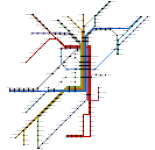(I'd understand if one of the mods wants to change the title of this thread.)
This is a thread for transit planning ideas that are so bad, they'regood amazing.
This is not a thread for actually criticizing proposals. This is also not a thread for trashing ideas that someone has proposed in good faith. This is supposed to be irreverent, and is supposed to be fun.
I'm talking about ideas that are absurd to the point of being silly. For example, my Project Blue Lace:

Or my "MMMMM Line":

As I described in the above links, these examples are what you get when you take individual segments that each seem vaguely reasonable in isolation, and then keep stringing them together without recognizing when too much is too much. If you were to pick a subset of these silly proposals (e.g. a suburban light rail line pinging between West Roxbury and Dover), they would make a vaguely reasonable proposal – maybe not a good enough proposal, but not necessarily something to reject on sight.
Shitposting is often used in cruel and callous ways, but I would argue that it also can be used as a form of Surrealism. There are benefits to setting aside concerns about quality, in favor of creative albeit "bad" ideas. Absurdist ideas can break us out of our conventions and lead us to reexamine old ideas in new light.
To be clear, a shitpost is not the same as a shit post. The ideas can be bad and irreverent, but they should be shared in the spirit of levity and creativity. A shit post is when someone abuses that creative space to have an excuse for acting like a shitty person. Let's not do that.
I'll start us off below with a silly absurd transit proposal that fails on so many feasibility measures it's downright laughable -- but which points to a few surprising points, relevant to serious transit proposals.
This is a thread for transit planning ideas that are so bad, they're
This is not a thread for actually criticizing proposals. This is also not a thread for trashing ideas that someone has proposed in good faith. This is supposed to be irreverent, and is supposed to be fun.
I'm talking about ideas that are absurd to the point of being silly. For example, my Project Blue Lace:
Or my "MMMMM Line":
As I described in the above links, these examples are what you get when you take individual segments that each seem vaguely reasonable in isolation, and then keep stringing them together without recognizing when too much is too much. If you were to pick a subset of these silly proposals (e.g. a suburban light rail line pinging between West Roxbury and Dover), they would make a vaguely reasonable proposal – maybe not a good enough proposal, but not necessarily something to reject on sight.
Shitposting is often used in cruel and callous ways, but I would argue that it also can be used as a form of Surrealism. There are benefits to setting aside concerns about quality, in favor of creative albeit "bad" ideas. Absurdist ideas can break us out of our conventions and lead us to reexamine old ideas in new light.
To be clear, a shitpost is not the same as a shit post. The ideas can be bad and irreverent, but they should be shared in the spirit of levity and creativity. A shit post is when someone abuses that creative space to have an excuse for acting like a shitty person. Let's not do that.
I'll start us off below with a silly absurd transit proposal that fails on so many feasibility measures it's downright laughable -- but which points to a few surprising points, relevant to serious transit proposals.


